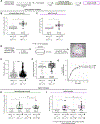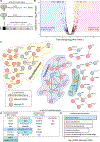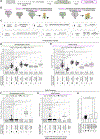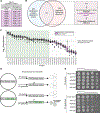Wolbachia-mediated reduction in the glutamate receptor mGluR promotes female promiscuity and bacterial spread
- PMID: 40347951
- PMCID: PMC12184626
- DOI: 10.1016/j.celrep.2025.115629
Wolbachia-mediated reduction in the glutamate receptor mGluR promotes female promiscuity and bacterial spread
Abstract
The molecular mechanisms by which parasites mediate host behavioral changes remain largely unexplored. Here, we examine Drosophila melanogaster infected with Wolbachia, a symbiont transmitted through the maternal germline, and find Wolbachia infection increases female receptivity to male courtship and hybrid mating. Wolbachia colonize regions of the brain that control sense perception and behavior. Quantitative global proteomics identify 177 differentially abundant proteins in infected female larval brains. Genetic alteration of the levels of three of these proteins in adults, the metabotropic glutamate receptor mGluR, the transcription factor TfAP-2, and the odorant binding protein Obp99b, each mimic the effect of Wolbachia on female receptivity. Furthermore, >700 Wolbachia proteins are detected in infected brains. Through abundance and molecular modeling analyses, we distinguish several Wolbachia-produced proteins as potential effectors. These results identify potential networks of host and Wolbachia proteins that modify behavior to promote mating success and aid the spread of Wolbachia.
Keywords: CP: Microbiology; CP: Neuroscience; Drosophila; Wolbachia; mGluR; mating; neurotransmission; proteomics; sense perception.
Copyright © 2025 The Authors. Published by Elsevier Inc. All rights reserved.
Conflict of interest statement
Declaration of interests The authors declare no competing interests.
Figures







Similar articles
-
Comparative analysis of Wolbachia maternal transmission and localization in host ovaries.Commun Biol. 2024 Jun 14;7(1):727. doi: 10.1038/s42003-024-06431-y. Commun Biol. 2024. PMID: 38877196 Free PMC article.
-
Endosymbiont control through non-canonical immune signaling and gut metabolic remodeling.Cell Rep. 2025 Jun 24;44(6):115811. doi: 10.1016/j.celrep.2025.115811. Epub 2025 Jun 6. Cell Rep. 2025. PMID: 40483691
-
Wolbachia infection confers post-translational modification of glutamic acid decarboxylase and other proteins in D. melanogaster.Microbiol Spectr. 2025 Jun 3;13(6):e0246524. doi: 10.1128/spectrum.02465-24. Epub 2025 Apr 28. Microbiol Spectr. 2025. PMID: 40293253 Free PMC article.
-
Behavioral interventions to reduce risk for sexual transmission of HIV among men who have sex with men.Cochrane Database Syst Rev. 2008 Jul 16;(3):CD001230. doi: 10.1002/14651858.CD001230.pub2. Cochrane Database Syst Rev. 2008. PMID: 18646068
-
Drugs for preventing postoperative nausea and vomiting in adults after general anaesthesia: a network meta-analysis.Cochrane Database Syst Rev. 2020 Oct 19;10(10):CD012859. doi: 10.1002/14651858.CD012859.pub2. Cochrane Database Syst Rev. 2020. PMID: 33075160 Free PMC article.
References
-
- Moore J (2002). Parasites and the Behavior of Animals (Oxford University Press; ).
-
- Rohrscheib CE, and Brownlie JC (2013). Microorganisms that Manipulate Complex Animal Behaviours by Affecting the Host’s Nervous System. Springer Sci. Rev. 1, 133–140. 10.1007/s40362-013-0013-8. - DOI
MeSH terms
Substances
Grants and funding
LinkOut - more resources
Full Text Sources
Molecular Biology Databases
Miscellaneous

